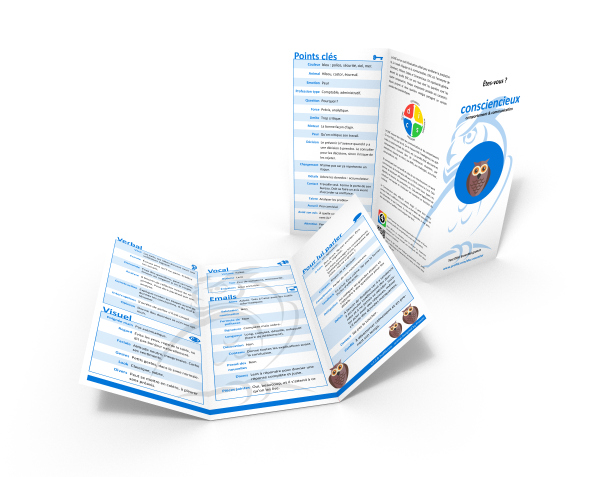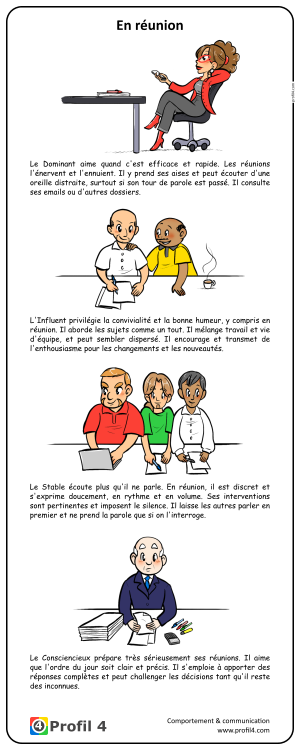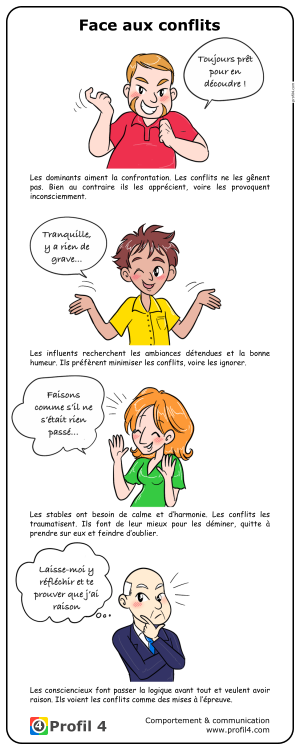Here are the results of EB*'s Essential test, taken on 07/10/2024.
His answers allowed us to establish his Essential profile according to the four main components of the DISCp4 model: Dominant (D), Influential (I), Stable (S) and Conscientious (C).
The DISCp4, an acronym of Dominant, Influent, Stable and Conscientious, is a grid for interpreting and understanding how EB* reacts to and interacts with his/her environment. This report uses the DISCp4 model to decipher EB*’s profile, examining how each component guides his/her actions, how he/she responds to different situations, and his/her mode of communication. Such an approach makes it easier to understand his/her personality in both professional and personal contexts.
DISCp4 profiles are presented on a color wheel divided into four quarters, each representing one of the components: Dominant (red), Influential (yellow), Stable (green) and Conscientious (blue). Each quarter has its own characteristics, but adjacent quarters share common traits. For example, the Dominant (D) and Influential (I) profiles are typically associated with extraverted traits.

It's perfectly normal for one person to straddle several components of the DISCp4 model and to have similar scores in different categories. As Marston explained, EB*'s profile is made up of the four colors to varying degrees of intensity. To interpret his/her profile each of these behavioral styles must be taken into account, reflecting the diversity and complexity of his/her personality.
Looking at people with a similar profile to his/her, as part of an essential approach, we can say that EB*...
- is reserved and aloof.
- prefers a simple, sober and minimalist style of dress.
- likes to work alone and prefers to carry out tasks independently.
- writes precise, detailed and meticulous emails with multiple attachments, believing (mistakenly) that people will pay attention to them.
- attaches great importance to details, which he/she collects and considers essential for carrying out his/her work meticulously.
- hesitates to make decisions for fear of getting something wrong. He/she wants to understand everything about a situation before making a decision, and may defer choices for as long some things remain uncertain.
- handles interactions and circumstances tactfully, applying a logical and structured approach.
- respectfully observes social norms, demonstrating politeness and courtesy in his/her manners.
- feels particularly uncomfortable with physical contact, so it's advisable to limit tactile gestures, with the exception of handshakes.
- scrupulously respects and honors regulations, procedures and legislation.
- strives for excellence in every aspect of his/her work, demonstrating a strong sense of perfectionism.
- is not particularly team-oriented, preferring to work and operate independently.
- is thoughtful, logical and rational.
- requires a logical basis to adhere to and support a decision.
- places great importance on procedures and rules.
- is highly organized and pays meticulous attention to detail.
- identifies, examines and finds solutions to problems.
- is afraid of making mistakes and feeling foolish.
- is not particularly attracted to novelty.
In addition to defining how EB*'s profile corresponds to the DISCp4 components, the model indicates his/her "adapted" and "natural" profiles.
The Adapted style represents his/her "public self", i.e. the facets of EB*'s personality that he/she presents in response to his/her environment. Described by Carl Jung as "the mask", it's the side of him/herself that he/she shows to others, reflecting the way he/she "appears" and adapts to external situations.
The Natural style embodies his/her "private self", revealing the aspects of his/her behavior that are most stable and least subject to variation. It corresponds to the facets of EB*'s personality that he/she has unconsciously adopted, and which remain the least influenced by the expectations of those around him/her. This style highlights EB*'s "true self", the one to which he/she instinctively returns when he/she struggles to keep up the appearance he/she has adopted in reaction to his/her external situation.
| d | i | s | c | |
| Adapted | 22 % | 0 % | 14 % | 62 % |
| Natural | 30 % | 0 % | 18 % | 54 % |
| Diff | -8 | 0 | -4 | 8 |
Discrepancies between the adapted profile and the natural profile are common. They indicate that the person concerned consciously or unconsciously feels the need to adjust to their environment, whether this means their team, their constraints, their task, etc. For example, an accountant may accentuate their conscientious side and a salesperson may seek to be more sociable, while a team leader may adopt a more authoritarian attitude. However, excessive discrepancies could suggest that EB* has over-analyzed the test questions. In this case, it may be wise to repeat the test at a later date, answering as spontaneously as possible, in order to obtain more reliable results.
It's also interesting to examine how EB*'s profile is positioned in terms of the dominant-stable and conscientious-influential diagonals...
Purple : adapted • Yellow : natural
The DISCp4 model is based on a thorough statistical analysis of behavioral styles among the general public, identifying common characteristics and trends. This model is designed to describe the behavior of so-called "normal" people i.e. those who do not have specific pathologies such as insomnia, mental disorders or other conditions significantly affecting behavior. Thus, the DISCp4 provides a framework for understanding and interpreting different behavioral and communication styles in a daily context, outside of any specific medical or psychological considerations.
This report draws its conclusions from the analysis of population statistics and establishes EB*'s profile based on that of people with a similar one. However, it is important to remember that each person is unique, including EB*, so some of his/her character traits may be slightly different from those presented here, depending on the context and circumstances.
Test date: 10/07/2024
Test duration: 9 minutes
(*) For reasons of confidentiality and because you are not logged in or you are neither the owner of this profile nor the person who assigned this test, all names have been replaced by EB*. Please log in to see reveal the hidden information.
This test was brought to you by the Profil4 team. Please feel free to recommend it to your co-workers and friends.The next step is to discover the DISCp4 model using the documentation offered on this site as well as in the FAQs.
It is also possible, and recommended, to participate in one of our training courses, alone or with your team.
And, of course, this profile will be even more valuable if it is shared with colleagues, friends, parents, etc.
Free mementos
This mementos sum up the main characteristics of the DISCp4 profiles.
They are the ideal complement for understanding test results and adapting your communication to the context.
Strips
Check out some illustrations related to DISCp4.









